

Defense Intelligence Agency. The Defense Intelligence Agency (DIA) is a United States federal agency under the Department of Defense, which serves as the country's main foreign military espionage organization.
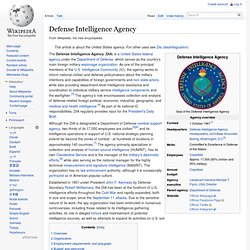
As one of the principal members of the U.S. Intelligence Community (IC), the agency works to inform national civilian and defense policymakers about the military intentions and capabilities of foreign governments and non-state actors, while also providing department-level intelligence assistance and coordination to individual military service intelligence components and the warfighter.[3] The agency's role encompasses collection and analysis of defense-related foreign political, economic, industrial, geographic, and medical and health intelligence.[4] As part of its national IC responsibilities, DIA regularly provides input for the President's Daily Brief.
Established in 1961 under President John F. Overview[edit] Organization[edit] DIA is organized into three directorates and five regional centers[14] Snowboarder leads Army members with distinction. They were part of an Australian Defence Alpine Snowsports Association triservice team of 21 personnel which participated in the biennial Exercise Alpine Challenge.

The team members trained in Italy’s Aosta Valley and represented the Australian Defence Force (ADF) in both the Royal Navy alpine championships in Tignes, France and the British interservices snowsports championships in Meribel, France. Army was represented in force at both competitions with four skiers and seven snowboarders. Its female competitors took home medals and trophies. Sergeant Bianca Kaden achieved podium positions at both championships including winning the slopestyle and finishing second in the boarder cross events in Tignes.
“I trained particularly hard for the slopestyle event so I was stoked to take out first place,” Sergeant Kaden said. “Air Force’s Flight Lieutenant Amanda Gosling was a big challenge for me during the boarder cross event. Distinguished Service Medal. Penguin feels the burn to raise funds. Eleven trainee divers from HMAS Penguin took part in the annual Balmoral Burn foot race in Sydney last Sunday.
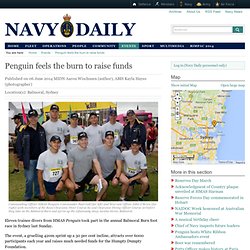
The event, a gruelling 420m sprint up a 30 per cent incline, attracts over 6000 participants each year and raises much needed funds for the Humpty Dumpty Foundation. Finishing with a respectable time of 2:21, Seaman King, a member of the Basic Clearance Diving Course 82 at Penguin, said he was happy with his teams result. “In true Navy style, we ran the race as a team and with a berthing hawser,” Seaman King said.
“It’s not an easy run and we didn’t make it any easier with the hawser, but we reckon we did a pretty good time.” “We run Awaba St, where the race is staged, a fair bit with our training so it was good to be able to run it today as a bit of fun.” Seaman King admits it’s not all about the result and said he was happy to be there to support a worthwhile cause. “It is always nice to be able to interact with the local community and support a meaningful cause,” Seaman King said.
Home Page : Department of Defence, Australian Government. Defence Ministers. Australian Army Cadets - CPL Ben Roberts-Smith – ANZAC day encounter with cadets. At the end of their Anzac Day march through the streets of Sydney, the cadets of 203 ACU were ready to call it a day.
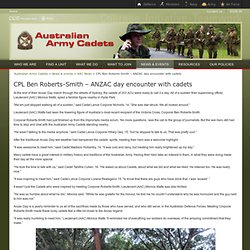
All of a sudden their supervising officer, Lieutenant (AAC) Monica Watts, spied a familiar figure nearby in Hyde Park. “Ma’am just stopped walking all of a sudden,” said Cadet Lance Corporal Nicholls, 14. “She was star-struck. We all looked around.” Lieutenant (AAC) Watts had seen the towering figure of Australia’s most recent recipient of the Victoria Cross, Corporal Ben Roberts-Smith. Corporal Roberts-Smith had just finished up from the impromptu media scrum. “He wasn’t talking to the media anymore,” said Cadet Lance Corporal Hillary Oeij, 15, “but he stopped to talk to us. After the traditional Anzac Day wet weather had dampened the cadets’ spirits, meeting their hero was a welcome highlight. “It was awesome to meet him,” said Cadet Madison Hollamby, 14. Operation Slipper. Afghanistan[edit] First phase[edit] A No. 33 Squadron Boeing 707 refuelling a US Navy F/A-18 in 2002.

Sikorsky MH-60 Jayhawk. This article is about the United States Coast Guard version of the Sikorsky S-70 helicopter series.
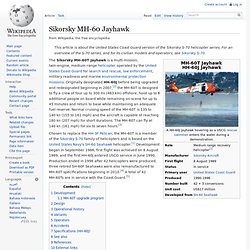
For an overview of the S-70 series, and for its civilian models and operators, see Sikorsky S-70. The Sikorsky MH-60T Jayhawk is a multi-mission, twin-engine, medium-range helicopter operated by the United States Coast Guard for search and rescue, law enforcement, military readiness and marine environmental protection missions. Originally designated HH-60J before being upgraded and redesignated beginning in 2007,[2] the MH-60T is designed to fly a crew of four up to 300 mi (483 km) offshore, hoist up to 6 additional people on board while remaining on-scene for up to 45 minutes and return to base while maintaining an adequate fuel reserve.
Normal cruising speed of the MH-60T is 135 to 140 kn (155 to 161 mph) and the aircraft is capable of reaching 180 kn (207 mph) for short durations. The MH-60T can fly at 140 kn (161 mph) for six to seven hours.[3] Development[edit] Design[edit] Performance. Sikorsky HH-60 Pave Hawk. "HH-60" redirects here.

Category:Military education and training in Australia. Category:Special forces of Australia. Category:Wars involving Australia. Australian contribution to the 2003 invasion of Iraq. The Howard Government supported the disarmament of Iraq during the Iraq disarmament crisis.

Australia later provided one of the four most substantial combat force contingents during the 2003 invasion of Iraq, under the operational codename Operation Falconer. Part of its contingent were among the first forces to enter Iraq after the official "execute" order.[1] The initial Australian force consisted of; three Royal Australian Navy ships, 500 special forces soldiers, P-3 Orion maritime patrol aircraft, C-130 Hercules transport aircraft and No. 75 Squadron RAAF (which included 14 F/A-18 Hornet fighters). Combat forces committed to Operation Falconer for the 2003 Invasion were withdrawn during 2003. Under the name Operation Catalyst, Australian combat troops were redeployed to Iraq in 2005, however, and assumed responsibility for supporting Iraqi security forces in one of Iraq's southern provinces.
Forces committed[edit] F/A-18 aircraft and ground crew from No. 75 Squadron. Battle of Same. Prelude[edit] Alfredo Reinado was a significant figure during the crisis, leading a mutiny in May 2006 during which nearly 600 soldiers deserted and triggered clashes between rival factions of the Timor Leste Defence Force (F-FDTL) and the National Police of East Timor (PNTL).[1] He was subsequently detained on charges of murder and mutiny.
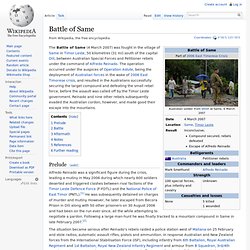
However, he later escaped from Becora Prison in Dili along with 50 other prisoners on 30 August 2006 and had been on the run ever since, all the while attempting to negotiate a pardon. Following a large man-hunt he was finally tracked to a mountain compound in Same in late February 2007.[2] Top 30 Acquisition Projects: Defence Materiel Organisation. Home « Fisher House UK Fisher House UK. A 'home away from home' for the families of our heroes. The Need When an individual suffers a life-changing injury or illness, their loved ones want to be by their side.

They do not need the added stresses of where to stay or how they will fund accommodation, they need support and reassurance. To this end, Help for Heroes, in partnership with The Queen Elizabeth Hospital Birmingham Charity and the US charity, Fisher House Foundation, has delivered Fisher House UK - a ‘home away from home’ for wounded patients and their loved ones at Queen Elizabeth Hospital Birmingham (QEHB). The Household Cavalry Museum London. The Household Cavalry Museum is unlike any other military museum because it offers a unique ‘behind-the-scenes’ look at the work that goes into the ceremonial duties and operational role of The Household Cavalry. From a glazed screen inside the Museum, visitors can view into the working stables of The Queen’s Life Guard. Visitors can see troopers working with horses in the original 18th century stables and hear first hand accounts of their rigorous and demanding training.
The Museum comes alive with compelling personal stories, interactive displays and stunning rare objects – many on display to the public for the first time. The Household Cavalry Museum sits within Horse Guards in Whitehall, central London, one of the city’s most historic buildings. Defence Environmental Management. Home : Defence Support and Reform Group : Department of Defence. Defence Support and Reform Group (DSRG) is the consolidated service delivery organisation for Defence.
DSRG's mission is to be an innovative, agile and cost effective support service that enables and enhances the delivery of Defence capability. DSRG's vision: Supporting Defence capability and enabling Defence priorities. DSRG has a budget of about $3.9 billion, with an asset base with a gross replacement value in excess of $62 billion and around 4,000 civilian and 1,100 military staff.
DSRG also works closely with a contracted workforce to deliver support services.